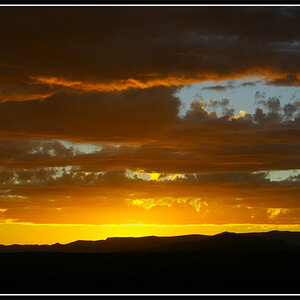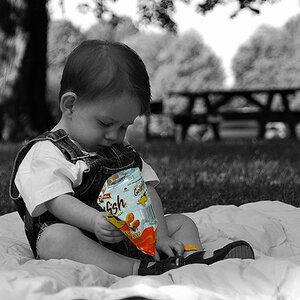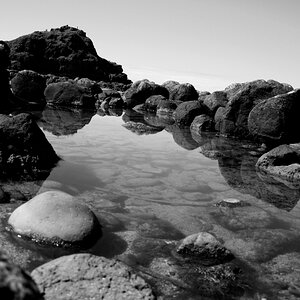Ysarex
Been spending a lot of time on here!
- Joined
- Nov 27, 2011
- Messages
- 7,139
- Reaction score
- 3,701
- Location
- St. Louis
- Can others edit my Photos
- Photos OK to edit
85mm lens. Desired: 8.47 foot tall field of view, to show a man and woman, standing, full-length, with some space below their feet, and above their heads.
With a Full Frame sensor, this field of view height (8.47 feet) is achieved at 20 feet camera-to-subject distance; with a 1.6 x APS-C sensor it's right around 34.5 feet distant, to get the same, exact height (a 1.53x Nikon or Sony sensor is a little,tiny bit closer).
Soooooo: guess what! Moving the APS-C camera BACK, farther from the subject, causes the depth of field to increase, compared to the 20.0 foot camera-to-subject distance that the full-frame camera requires; that distance change causes 1) a greater (longer) camera-to-subject distance, and 2)tends to alter how far behind the background is in relation to the camera's sensor and 3) moves the focus distance closer to the Hyperfocal Distance.
The smaller the sensor is, the CLOSER the camera-to-subject distance is at the range where background objects move into a fairly deep DOF range. At the closest ranges, DOF is skimpy; as camera-to-subject distances increase, to say, beyond 20 feet, DOF increases at a VERY rapid rate. DOF is NOT a linear thing!
There's a point where the full-frame 24x36mm sensor and normal, common lenses like 50mm, 70-200, 85mm, 100mm, 135mm, offer a combination of shallow DOF and a high degree of background blurring, which can be utilized for creative effects. What happens with smaller sensors, like m4/3, APS-C, and smaller, is that there is a LOT of depth of field beginning in the 10- to 20-foot camera-to-subject range; the toughest thing to wrap one's head around when using on-line DOF calculators is this: DOF is easy to quantify with numbers,and it might seem that there's little difference between one format size and another, but the quality of the out of focus (meaning the degree of de-focus, not the bokeh quality) in the background is tricky to describe or to delineat or to define with numbers; the problem is that the human brain and eye can "recognize" many things in a backdrop, unless that backdrop is really,really defocused.
A second problem relating to DOF is that with smaller sensors, the wider-angle focal lengths are VERY short! This means shooting at 17,18,19mm on APS-C gives almost totally hyperfocal focus at CLOSE ranges, and means that getting OOF backdrops on wide-angle shots is impossible, or very difficult, or requires crazy-short, crazy-fast wide-angle lenses to get OOF backdrops.
There are basically three DOF ranges: close-in, moderate, and longer-range. DOF does NOT behave in a linear, perfect manner. Small-sensor cameras CAN create some (note: 'some') shallow DOF effects at macro and close-up ranges, but at medium ranges, and at longer range, small-sensor cameras tend toward deep DOF and easily-recongizable backdrops; Medium and larger-format (6x6,6x7,6x8,6x9 cm images being Medium format, and 4x5,5x7,and 8x10 inch being Large Format) cameras create images with shallow DOF to incredibly shallow DOF.
The FORMAT's SIZE, and the lenses that are used to make each and every Picture Angle of View, or ever single Picture Frame Size, have a MAJOR influence on the DOF, in most cases in the close-up to medium-range situations.
Seriously....listen to me..listen to Ysarex...this has been covered here a dozen times or more, over a decade...listen to Ysarex, not idiots on YouTube who cannot tell the difference between an APS-C shot and an iPhone shot and a Medium Format film shot. If you have ***ever*** shot a 6x6 cm film camera, you KNOW that format size can play a HUGE part in the kind of DOF you get, and the types of images you can create.
Bob Atkins has some fantastic articles on-line, that show the differences between FX (FF) and APS-C cameras, in regards to DOF. As well as an excellent field of view and DOF calculator.
Hi Derrel, Here we go again -- kinda like trying to slay a hydra.
Joe


![[No title]](/data/xfmg/thumbnail/36/36657-3774cdd7ebbafa5ccac2741386b9949a.jpg?1619737675)
![[No title]](/data/xfmg/thumbnail/39/39499-b11b4321c0f029e3a5523ccab621b71c.jpg?1619739057)


![[No title]](/data/xfmg/thumbnail/39/39498-362f11d9bfd0d9e222faa85b38801745.jpg?1619739056)




![[No title]](/data/xfmg/thumbnail/42/42056-76026251cb5ebb85b4a4d281d36121d8.jpg?1619739992)

![[No title]](/data/xfmg/thumbnail/35/35932-28690c4fc247cf491230e47fc70ebeb5.jpg?1619737235)